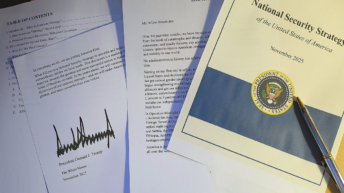
The geopolitical landscape of the Indo-Pacific region is experiencing major changes as a result of the foreign policy approach of the Trump administration which is centered on a protectionist ‘America First’ policy, strategic shifts, and escalating tensions between the U.S. and China erupting in a trade war. Trump’s foreign policy is aimed at countering China’s influence in the Indo-Pacific by implementing aggressive protectionist measures, particularly by implementing tariffs and pursuing technological decoupling. Currently, the U.S. has instituted total tariffs of 145% on imports from China, which are already disrupting supply chains within the Indo-Pacific region and around the world.
The main goal of Trump’s tariffs on Beijing, particularly concerning high-tech goods, is to trigger a shift in supply chains away from China. However, it is hard to predict who will gain from the supply chain disruption since most other nations are also experiencing the impact of Trump’s tariffs, although their enforcement announced has been suspended for 90 days (except for 10% flat tariff on almost all imports) following the initial announcement, excluding China.
Trump’s tariff measures have also triggered retaliatory actions from Beijing through the imposition of a 125% tariff on imports from the US, escalating economic tensions and fragmenting regional trade networks in the Indo-Pacific. Southeast Asian economies that significantly depend on trade with China could confront challenges that necessitate a shift in their economic approaches, creating an atmosphere of uncertainty in the Indo-Pacific. The Southeast Asian ‘connector states’ such as Vietnam, Thailand, and Malaysia etc, which gained advantages from ‘China+1’ supply chain diversification efforts, may now experience indirect negative effects due to U.S. tariffs aimed at them and other countries with trade surpluses
The transactional approach that Trump has taken towards USA’s alliance partners and his skepticism about multilateral organisations could result in the weakening of regional security frameworks in the Indo-Pacific, including the Quad and AUKUS. While Trump wants U.S. allies such as Japan, South Korea, and Australia etc. to assume greater defense responsibilities, his insistence on ‘burden-sharing’ could strain these relationships. For instance, Japan’s decision to increase its defense expenditure to 2% of GDP demonstrates its efforts to meet U.S. expectations, but Trump’s unpredictability undermines trust in existing commitments. Japan has already retaliated fiancially against American policies that hurt its export and imperil its economy Similarly, AUKUS faces uncertainty due to cost overruns and the potential for U.S. withdrawal, which could leave Australia to manage heightened strategic risks on its own.
The ASEAN-led framework in Southeast Asia is also facing significant challenges. Trump’s lack of interest in multilateral agreements could lead to diminished U.S. involvement in multilateral forums such as the East Asia Summit (EAS) which may further weaken ASEAN’s central role and allow China to boost its influence in Southeast Asian countries. Trump’s disregard for Southeast Asia, highlighted by minimal high-level interactions and the elimination of USAID, undermines U.S. soft power, prompting countries like Indonesia to seek out alternatives like BRICS and alliances with middle powers in the Indo-Pacific region.
In the South China Sea, countries like Vietnam and the Philippines, which are U.S. allies, are struggling with uncertainties regarding Trump’s commitment to countering Chinese assertiveness. Although a firmer approach towards China might enhance defense collaboration, Trump’s quid-pro-quo demands—such as requiring financial contributions against security guarantees—could put Vietnam and the Philippines at risk in the Indo-Pacific.
Taiwan and North Korea represent two significant conflict zones in the Indo-Pacific region. Trump’s ambiguous and wavering attitude to the region could worsen tensions. His previous ‘rocket man’ comment directed at Kim Jong Un and unclear policy on Taiwan may create the potential for errors in judgment, which could destabilize the Indo-Pacific region. Although Trump’s administration includes strong critics of China, his fluctuating position on Taiwan—viewing it more as a bargaining tool rather than a democratic ally—increases the likelihood of a Chinese sudden or gradual takeover of the island.
India’s attempts to enhance manufacturing via reforms and initiatives like ‘Make-in-India’ could face challenges in the short term due to U.S. restrictive measures, such as reductions in H-1B visa quotas, and introduction of additional baseline tariffs with a possibility for an increase at the end of the 90 days ‘pause’ period. The Indian purchases from the USA in the energy and defence industries could help reduce these trade conflicts. While strengthening military and energy connections with the U.S., India aims for an independent non-aligned approach, working to stabilize its relationship with China and engaging with Russia. In this context, Trump’s pragmatic stance on Russia could potentially reduce friction in the dynamics of India-U.S. relations.
The protectionist measures under Trump’s ‘America First’ policy, such as potential new tariffs on exports from South Asian and Southeast Asian countries, could negatively impact the economies of export-dependent nations. Furthermore, the potential failure of the Indo-Pacific Economic Framework (IPEF) would create a regional economic leadership vacuum in the Indo-Pacific, which China could fill through initiatives like the Belt and Road Initiative and the Regional Comprehensive Economic Partnership (RCEP).
A decrease in U.S. involvement in East Asia and Southeast Asia will undoubtedly encourage China and Russia to broaden their influence. Countries like Indonesia and Singapore, reliant on a balance of power, may face difficult choices as the U.S. retreat diminishes their strategic security. Additionally, Myanmar’s military junta could take advantage of the reduced U.S. attention to evade international scrutiny. As a result, regional hedging strategies are likely to intensify, with countries such as Vietnam, Australia, and India seeking to capitalize on U.S.-China rivalry while avoiding overdependence on either power.
Trump’s second term is spreading instability in the Indo-Pacific through a mix of transactional diplomacy, economic unilateralism, skepticism about alliances, trade fluctuations, and unpredictable foreign policy strategies. Although some countries might take advantage of the opportunities arising from the U.S.-China competition and trade war, the larger Indo-Pacific region confronts greater risks of fragmentation, power vacuum, and intensifying competition among major powers. The challenge for Indo-Pacific nations will be to manage this instability while maintaining their autonomy in a world order that is increasingly becoming polarised and multipolar.
In transactional diplomacy, relationships are based on quid pro quo rather than shared values or long-term strategic interests; erratic and unpredictable foreign policy decisions are making it difficult for allies and adversaries alike to anticipate U.S. actions. Tthe overall impact on the Indo-Pacific is likely to be negative. The region could face increased fragmentation, as countries are forced to choose sides or go it alone, and intensifying competition among major powers, including China and India.
They will need to balance their relationships with the U.S. and China, hedge against uncertainty, and build resilience to withstand external shocks.






Add comment